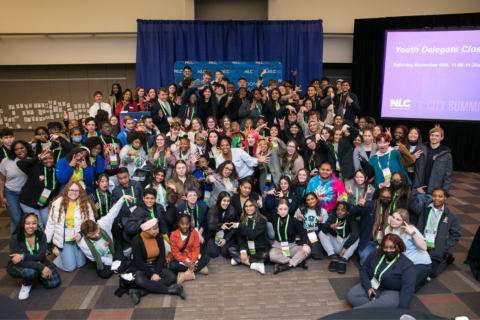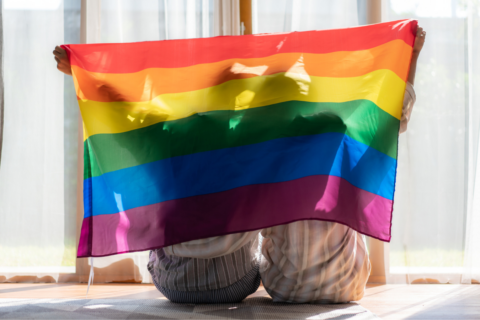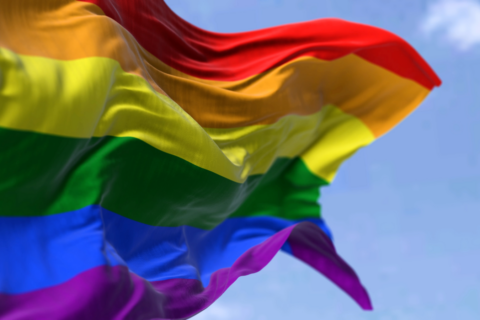In January 2004, just months before Massachusetts would become the first in the nation to legalize same-sex marriage, residents of a small town erupted in debate. To celebrate multiculturalism and tolerance, the local middle school had hung more than 60 national flags throughout the hallways as part of its “Respect for Differences Day” programming. Alongside the numerous national flags, the school also hung a rainbow flag, reportedly donated by a teacher.
Some parents arrived at the local council meeting to decry the flag’s presence and question the appropriateness of discussing sexuality with middle school students. Others submitted a petition to have it removed and filed a complaint with the Board of Education. A number of residents wrote to local papers, accusing the unnamed teacher of pushing an agenda.
Providing Love and Support
In reality, a key part of the agenda for hanging the flag, according to the school Superintendent at the time, had been to provide a measure of love and support for students. According to the town’s Youth Risk Survey, 10 percent of seventh graders had attempted suicide in the previous school year, and those questioning their sexuality were five times more likely to do so.
The implied or explicit charges that parents made, opining that the flag was intended to push an agenda or force students to consider inappropriate sexual subject matter may sound familiar — and it is. The characterization of LGBTQ+ identity as part of a nefarious plot, and therefore necessary to keep out of the public sphere, has a long history, part of a misinformation campaign first documented more than a century ago.
A Look Back in History: The Lavender Scare
The first high-profile example comes as early as 1906, when a German newspaper editor accused a “homosexual clique” within Kaiser Wilhelm II’s cabinet of exerting influence that “had brought about Bismarck’s dismissal, cut off the emperor from his people, and, with its undue pacifism, maneuvered Germany not only into isolation, but to the brink of war.” Following World War II, a similar narrative would gain traction in the United States, reaching a fever pitch during the “Lavender Scare.”
“Seventy years ago, as the Cold War set in, President Eisenhower signed an Executive Order banning LGBTQI+ Americans from serving in the Federal Government,” wrote President Joe Biden in an April 26 Proclamation marking the 70th anniversary of the event. “It was a decades-long period when 5,000 to 10,000 LGBTQI+ federal employees were investigated, were interrogated, and lost their jobs simply because of who they were and whom they loved.” Throughout this period, Senator Joseph McCarthy explicitly linked homosexuality to the perceived threat of communism, claiming that gay men were more susceptible to communist recruitment due to inherent moral failings and psychological disturbances. Like communists, this false narrative suggested, homosexuals were engaged in activities to recruit others to their secretive subculture. Such misinformation ultimately ruined the professional lives of thousands of public servants.
Misinformation Narratives
As queer culture became more visible in the 60s and 70s, misinformation narratives adapted, moving away from conceptualizing LGBTQ+ people as national security threats but doubling down on claims of recruitment and shadowy behavior. Anita Bryant’s 1977 “Save Our Children” campaign exemplified the shift from framing the general public as being at risk and towards painting queerness as a threat to children. “Homosexuals cannot reproduce, so they must recruit,” Bryant claimed. “And to freshen their ranks, they must recruit the youth of America.”
This is the narrative that continues today, and that enflamed tensions among parents 20 years ago: that knowledge and tolerance of LGBTQ+ identity is a threat to children. In recent years, those pushing misinformation have increasingly used terms associated with child sexual abuse, such as “grooming,” to promote the long-standing and scientifically disproven claim that LGBTQ+ individuals abuse children at higher rates.
Such falsehoods have consequences. According to the American Psychological Association, stigma, discrimination and stereotypes fueled by misinformation provide fodder for anti-LGBTQ+ legislation and policies, which negatively impact mental health and wellness. Accusations of grooming have led to a spike in threats and assaults against LGBTQ+ people, and LGBTQ+ youth in unsupportive environments are 20 percent more likely to commit suicide than those in supportive environments.
Debunking the Falsehoods of Harming Children
The notion that LGBTQ+ pride or the open expression of queer identity can harm children has been debunked again and again, and yet it remains as potent a political cudgel as the false charges being levied in 1906 Germany and Cold War America. When gay employees, or those suspected of being gay, were purged from the U.S. Government’s ranks in the Lavender Scare, the country lost not only committed public servants but highly trained experts and the future contributions they might have made to the national interest. Children who see members of their community condemn symbols of LGBTQ+ identity — flags, books, movies and even their own teachers — are left with lasting psychological harm and may even be pushed to suicide. Even those with supportive families are impacted, as parents contemplate moving out of their communities and become fearful of their own neighbors. Communities will lose out on neighbors, friends and young minds who might otherwise have grown up to become councilmembers, teachers, firefighters and business owners in their hometowns.
Local leaders can play an important role in keeping members of their community safe and reminding them that they belong. Modeling respectful behavior sets an important tone and making space for LGBTQ+ members of the community to participate in civic life help to establish a community norm. Standing up to misinformation and hate speech are essential to preventing violence and intimidation. While all members of the community are entitled to First Amendment protections, harmful lies should never go unchallenged. Pushing back may not change the opinion of the person making the claim, but it can stop the spread of misinformation and the associated harm.
The strength of cities, towns and villages lies in the people who live there and the extraordinary range of contributions they make— intellectually, financially, artistically, and in many other ways. By rejecting misinformation and fostering acceptance, local leaders are investing in the long-term health of their communities, and in people who are proud to live there.







